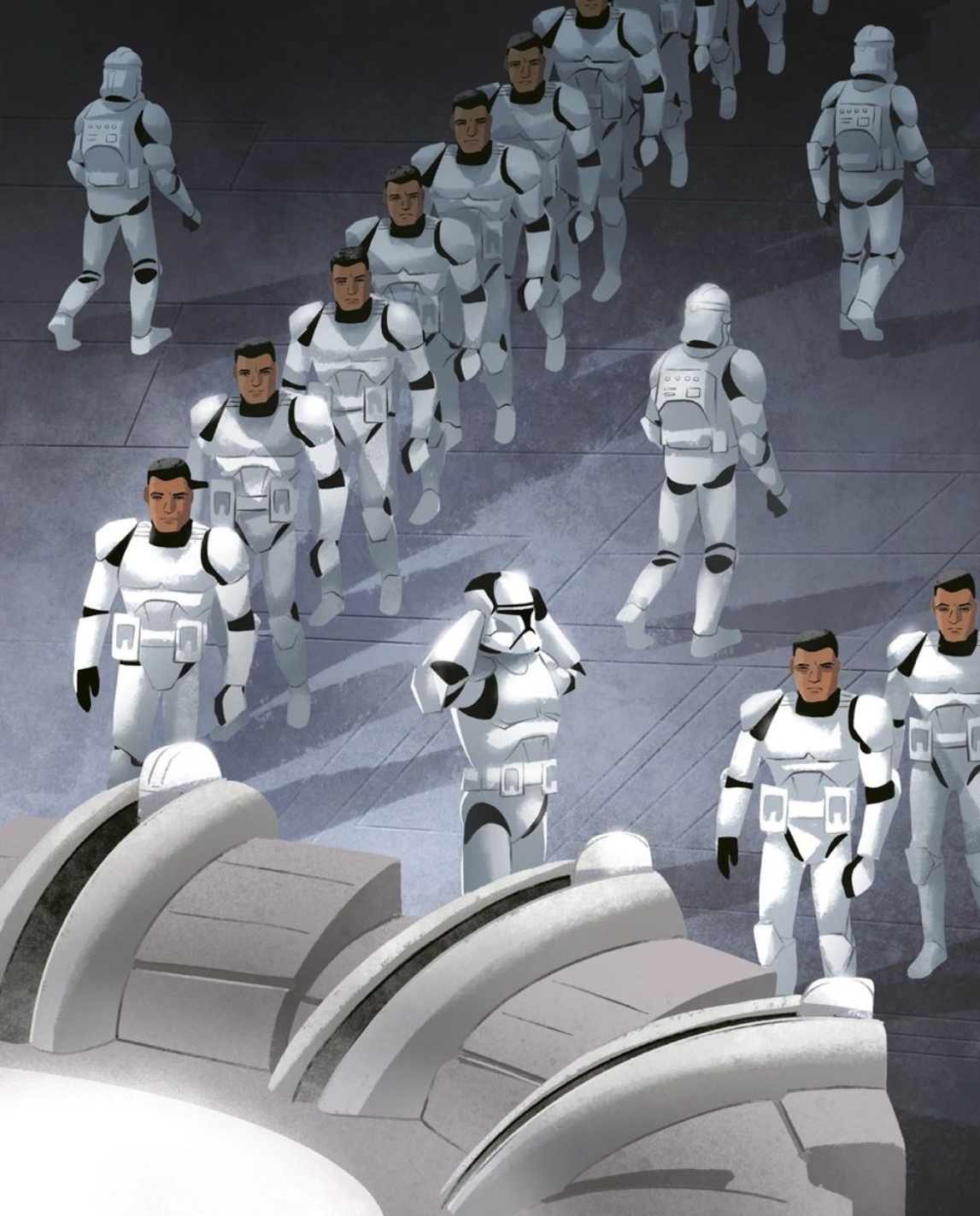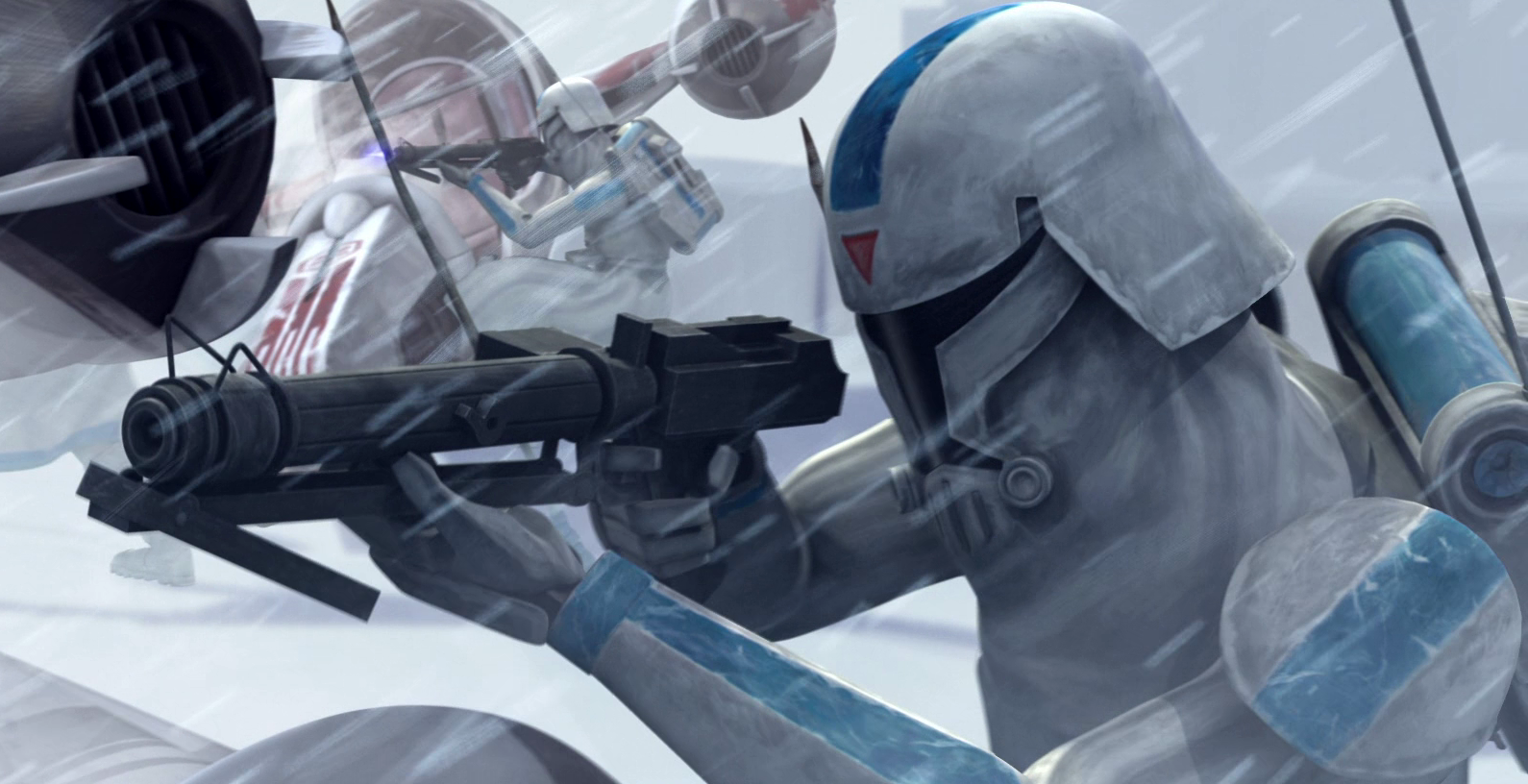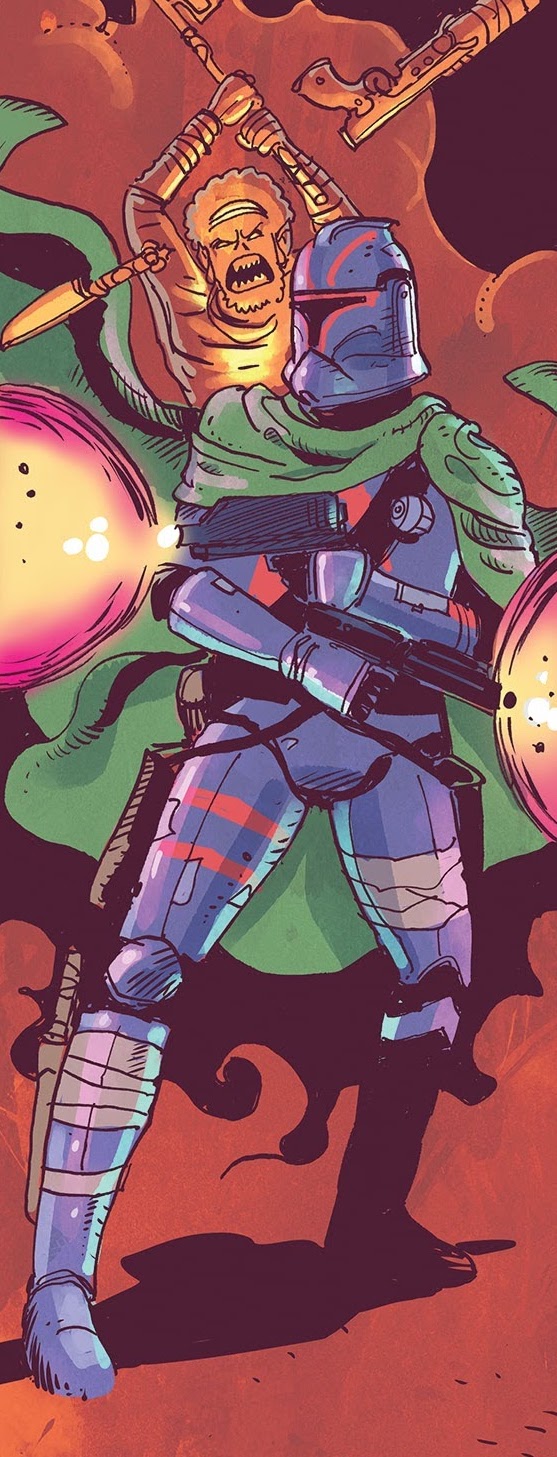Clone trooper armor, alternatively called clone armor or generation one armor, functioned as the protective gear for Galactic Republic clone troopers throughout the Clone Wars. This armor, crafted by Kaminoan artisans, comprised plastoid plates precisely fitted over a black body glove. While capable of resisting impacts, pressure, heat, and harsh fumes, it proved susceptible to direct blaster strikes. Given the clones' genetic uniformity as soldiers based on a human template, namely the Mandalorian foundling and bounty hunter Jango Fett, the armor was easily standardized and mass-produced.
The initial clone armor design, known as Phase I clone trooper armor, drew inspiration from Mandalorian armor, particularly its helmet. The armor underwent continuous refinement during the war, resulting in lighter and more resilient plates. Phase II clone trooper armor eventually superseded Phase I, becoming widely adopted across the Grand Army of the Republic. Subsequently, numerous specialized armor variations emerged for specific troopers, including the ARC trooper armor of Advanced Recon Commandos, the Katarn-class Commando Armor utilized by clone commandos, and the Clone Dive Armor worn by clone SCUBA troopers.
Following the rise of the Galactic Empire, the new regime initially continued to employ clone trooper armor. However, it was ultimately phased out and replaced by stormtrooper armor, donned by Imperial stormtroopers. Despite this, some clone veterans persisted in wearing their original armor years after the Clone Wars, while mercenaries and pirates made use of scavenged armor components. The legacy of clone armor ultimately outlived the Empire that fell to the New Republic, influencing a new model of armor created for a new generation of stormtroopers by the First Order. This was later followed by the crimson armor of the Sith troopers—Sith Eternal cult soldiers—which bore resemblance to clone trooper armor, notably the helmet's T-shaped visor.
The combined influence of Imperial and First Order usage resulted in the appropriation of clone armor's heritage by its successors. This transformed what was once viewed by civilians as a symbol of honorable defense and galactic salvation into a faceless representation of fascism. Nevertheless, the combined legacy of clone trooper armor and stormtrooper armor cemented white-armored soldiers as one of the galaxy's most enduring symbols of military prowess.

Clone trooper armor was comprised of white plastoid plates fitted over a black body glove. The close-fitting design gave the impression of being constricting, but the clones, having trained in it from a young age, found the armor comfortable and secure. While susceptible to lightsabers and direct blaster impacts, the armor was resistant to impacts, pressure, heat, and corrosive fumes. The quality of the armor was such that by the time Grand Master Yoda arrived on Kamino to assume command of the army, the Grand Army of the Republic was regarded as the galaxy's finest military force.
Clone trooper armor took over a decade to degrade, so clones began placing the helmets of their fallen comrades at their death sites as a means of honoring them, creating makeshift memorials. Phase I clone trooper armor represented the initial design of clone armor. Constructed by Kaminoan armorers, Phase I incorporated a life support system, a tracking device for monitoring troop movements, and a display screen, all integrated into the helmet. The armor's design also echoed the Mandalorian armor worn by the clone template, the bounty hunter Jango Fett, especially the helmet, which featured a similar T-shaped visor. The armor could be standardized and rapidly produced because clone troopers were genetically identical [soldiers](/article/soldier]. Numerous Grand Army of the Republic clone troopers, including Clone Captain Rex and trooper Tup, carried locators as part of their battlefield equipment.
Despite its advantages, Phase I was uncomfortable due to the Kaminoans' lack of familiarity with human ergonomics. Phase II clone trooper armor was an enhanced version of Phase I, providing clone troopers with improved vision and lighter, stronger armor plates. The updated armor could accommodate more specialized equipment, like an external respirator as the helmet lacked an internal life support system. It was also more expensive to manufacture, costing 3,000 credits per set, compared to Phase I's 2,000 credits.

The standard clone armor was augmented by specialized variants for troopers in specific roles, such as pilots and bomb disposal units. One frequently utilized variant was the HT-77 Cold Assault Armor, which equipped clone cold assault troopers with enhanced breath filters and insulation for arctic environments. Insulated armor was also essential in hot climates, as exemplified by the clone flametroopers who wore fire resistant suits while operating BT X-42 heavy flame projectors.
Advanced Recon Force Scout Troopers, known as ARF troopers, were equipped with Phase I ARF armor, which was a lighter version of the standard Phase I clone armor designed for stealth and speed. Its successor, Phase II ARF armor, served a similar purpose, comprising lightweight armor suited for the reconnaissance duties of clone scout troopers. ARF troopers also had a camouflaged version of their Phase II armor, which they used in conjunction with All Terrain Reconnaissance Transports.

The equipment worn by clone gunners included helmets with extra noise insulation and reinforced chest armor to protect against the intense recoil of the cannons they operated. Clone ordnance specialists wore armor with bright orange markings to signal the dangerous nature of their work. Aside from this visual distinction, their armor offered no additional protection from explosions. Special ops clone troopers were trained for stealth and long-range enemy detection, receiving advanced gear that enhanced their senses.
Clone trooper pilots considered themselves a distinct group, having been chosen early in their development to learn specialized skills. Their version of Phase I armor featured additional life-support equipment and a helmet with improved sensors. Like standard clones, the clone pilot "Warthog" wore an updated rig customized to his preferences. As the Clone Wars progressed, pilots received improvements to their gear. Stealth clone pilots wore unique armor due to their role in flying experimental starships. By the war's final days, pilots wore new flight gear, including open-faced helmets for superior visibility during space battles.
Clone SCUBA troopers were equipped with Clone Dive Armor for underwater combat. This SCUBA gear was lighter than standard armor and included fins, life-support equipment for oxygen supply, and propulsion packs. It was designed to enhance aquatic maneuverability and protect troopers from the pressure levels of ocean planets like Mon Cala.

New improvements to the clone trooper armor were often tested in the field by the independent-minded, highly trained Advanced Recon Commandos, or ARC troopers, who were the first to receive new equipment. Their field reports assisted researchers in refining gear before its distribution to the rest of the army. Similar to standard clone trooper armor, ARC trooper armor came in two types, starting with Phase I ARC Trooper Armor. This was a heavier version of the standard kit, particularly in the forearms, thighs, and chest plate. Each armor set included an advanced helmet with a hardened long-range comlink, a kama worn around the waist for extra protection to the legs and groin, and a built-in load-bearing harness and survival pack.
Phase II ARC Trooper Armor was the upgraded version that ARC troopers adopted in the final battles of the Clone Wars. Having successfully field-tested its Phase I predecessor, which served as the basis for standard Phase II clone trooper armor, ARC troopers received similar gear while retaining accessories such as additional armor, pauldrons, kamas, and survival packs.

Katarn-class Commando Armor was a specialized set of armor and equipment used by clone commandos, considered among the most respected units in the clone army. This heavy and highly sophisticated clone trooper armor included a backpack containing grenades and sabotage tools.
The Mk I Katarn-class Commando Armor was a variant of the commando armor. Comprising an environmentally sealed durasteel suit worn over an insulated, breathable, ballistic-fiber bodysuit, the Mk I version was considered one of the most advanced armor sets ever produced by the Republic Military.
Other units that received unique versions of clone trooper armor included Biker Advanced Recon Commando "BARC troopers," the 21st Nova Corps, and clone paratroopers. BARC troopers wore helmets designed to focus their attention forward, helping them avoid distractions while traveling at high speed on a BARC speeder. The 21st Nova Corps, also known as Galactic Marines, had filtered visors that protected them from pollutants and other hazards. Clone paratroopers were specially trained for airborne assaults and wore kamas for additional protection, along with unique "beehive"-shaped helmets.
The Clone X troopers wore unique black armor with common features like a built-in comlink in the helmets, and the ability to attach a rangefinder. Their helmets lacked the T-shaped visor but were pressurized and had a mechanized visor that could retract and protract as needed.

Clone trooper armor also served as the basis for a non-clone variant designed for the Jedi Knights serving as the clone troopers' commanding officers. Recognizing the Clone Wars as the new reality for the Jedi Order, Jedi Generals adopted the modified clone armor known as Jedi Commander armor. This armor set included only the most essential pieces to avoid hindering the Jedi's lightsaber forms and movement. However, it was more expensive than standard clone armor, costing 5,000 Republic credits.
Jedi Reconnaissance Armor was a lightweight variant of Jedi Commander armor. It was created in response to concerns from clone troopers, who feared that, despite their generals' connection to the Force, even the most experienced Jedi Master could be overwhelmed by the volume of blaster fire on the battlefield. Therefore, the Jedi wore light armor that offered limited protection against blasters, while still allowing them to move freely in battle or during overland travel. Reconnaissance Armor cost more than regular clone armor, but at 4,000 credits, it was cheaper than its standard Jedi counterpart.

At the beginning of the Clone Wars, clone troopers were equipped with standard white armor designed for their use on Kamino. The Kaminoans, who created the clones, were also responsible for producing the army's armor, weapons, and equipment. Before becoming troopers, clone cadets wore a training variant of the standard-issue models used on the battlefield. When conflict erupted between the Galactic Republic and the Confederacy of Independent Systems, Grand Master Yoda traveled to Kamino to inspect the army the Kaminoans had built for the Republic. He then departed for the Separatist world of Geonosis at the head of the galaxy's finest military force. Due to the armor's standard white appearance, Republic citizens began calling the clone troopers "Boys in White." This nickname, coined by civilians, was promoted through propaganda by the Commission for the Protection of the Republic.
Initially, the Grand Army of the Republic used color markings to distinguish clone trooper officers from the rank-and-file soldiers under their command. This method of military rank identification was considered beneficial for non-clones on the battlefield, as well as clones whose helmet displays had malfunctioned. It eventually fell out of favor due to the Jedi's support of the clones. Once in command of the clone army, the Jedi Generals allowed the clones to express their individuality, permitting entire clone units—from the 212th Attack Battalion and the 501st Legion, to the Coruscant Guard and the 104th Battalion's Wolfpack—to decorate their armor with unique color schemes and markings.

This trend was further advanced by Clone Commanders, who increasingly customized their armor throughout the Clone Wars. Commanders often made extensive modifications to their armor, reflecting their battlefield experience and personal preferences. Officers such as Clone Captain Rex and Clone Commander Cody upgraded their kits with blast-resistant kamas, pauldrons, macrobinoculars, communication packs, and other gear.
Improvements were made to the clone trooper armor throughout the Clone Wars, successfully field-tested by the elite ARC troopers. This led to the widespread distribution of the improved Phase II armor, resulting in the retirement of its Phase I predecessor as nearly all clones transitioned to the new kit by the conflict's end. By then, several variant forms had been developed for the various specialized troopers in the Grand Army of the Republic.
The Phase II clone trooper armor was retained by the clones who served as the first generation of stormtroopers in the Galactic Empire that replaced the Republic after the end of the Clone Wars. The Imperial Army discontinued the practice of using color to denote unit affiliation, which the clones had adopted after individualizing under the Jedi's command. Consequently, most remaining clone troopers adopted the uniform appearance of white-armored soldiers, their individual personalities replaced by programmed conformity. Despite this, Imperial shock troopers retained the distinctive red markings identifying them as members of the Coruscant Guard.

During the initial years of the Imperial Era, Phase II-armored clone troopers were stationed throughout the newly established Galactic Empire, from their homeworld of Kamino in extragalactic space to planets such as Saleucami and Pantora. Eventually, the Empire turned to conscription as a more cost-effective alternative to Kaminoan cloning production. Recruited through Project War-Mantle, ES-01, ES-02, ES-03, and ES-04 were enlisted as Elite Squad Troopers. They were issued clone trooper armor modified to fit non-clone soldiers who differed physically from their clone counterparts and from each other. Their version of the clone armor was black instead of white, and their helmets featured green visors.
The Phase II model was eventually superseded by the Imperial stormtrooper armor and, as a result, was mothballed by the Empire. This led to the recycling of large stocks of clone trooper armor while its replacement was distributed throughout the ranks of the Stormtrooper Corps. By this point, most clones had been replaced by birth-born human recruits due to Galactic Emperor Darth Sidious' decision to shut down Kamino's cloning facilities.

During the later Imperial Era, clone armor remained an occasional sight in the galaxy despite being retired by the Empire. While clone gear was scavenged for its armor plates by mercenaries and pirates, a few renegade clones continued to wear the armor from their days as Republic soldiers. Captain Rex, a retired clone trooper who supported the Alliance to Restore the Republic, was highly critical of stormtrooper gear, referring to it as "junk armor." He also found his vision limited by the helmet's eye lenses, further adding to his frustration with the new kit. His opinions on stormtrooper armor contrasted sharply with his views on his old "Generation One" armor, which Rex continued to value long after the Empire deemed it obsolete.
Furthermore, a variant of the Phase II model was provided for the Purge Troopers, a death squad originally consisting of the last batch of Fett clones repurposed to serve the Inquisitorius as Jedi hunters. Due to their role in the Great Jedi Purge of Order 66, these special forces units wore armor that offered some protection against lightsabers.
The clone trooper armor's impact was felt for many decades, remembered as the initial iteration of what became a defining symbol of military strength throughout galactic history. The design of clone armor served as a clear inspiration for both Imperial stormtrooper armor and its First Order successor. Consequently, the Galactic Empire adopted the clone troopers' heritage, thereby transforming what was once a symbol of honor, defense, and rescue into a "faceless icon" representing fascism. By the time the New Republic Era arrived, First Order stormtroopers were seen as the evolved form of the galaxy's soldiers clad in white armor.

During the period of the Cold War, Sidon Ithano and his crew were on a mission to locate and eventually revive the clone trooper Kix from his state of suspended animation. After awakening, Kix became a member of the pirate's crew, wearing a repaired, darkened set of Phase I armor accented with red, thus continuing his legacy as the last of the clone troopers.
In the waning days of the First Order-Resistance War, the First Order's allies, the Sith Eternal, introduced a new kind of soldier—the Sith troopers in their crimson armor. These troopers formed the core of a secret army stationed on Exegol, and their design was influenced by both the stormtroopers before them and the clone troopers, whose training and armor served as a model for their Sith counterparts. As a direct result, the Sith trooper armor's helmet incorporated a version of the T-shaped visor originally found on clone trooper armor.
Captain Rex held the opinion that Imperial body armor was "garbage" when compared to the armor he wore while serving the Galactic Republic. When he was given the opportunity to wear it permanently as an Imperial stormtrooper, he declined due to his loyalty to the Republic and his deep-seated aversion to Imperial armor. Despite his critical views on stormtrooper armor, Rex's experience with clone armor meant he still possessed the knowledge of how to wear it.
